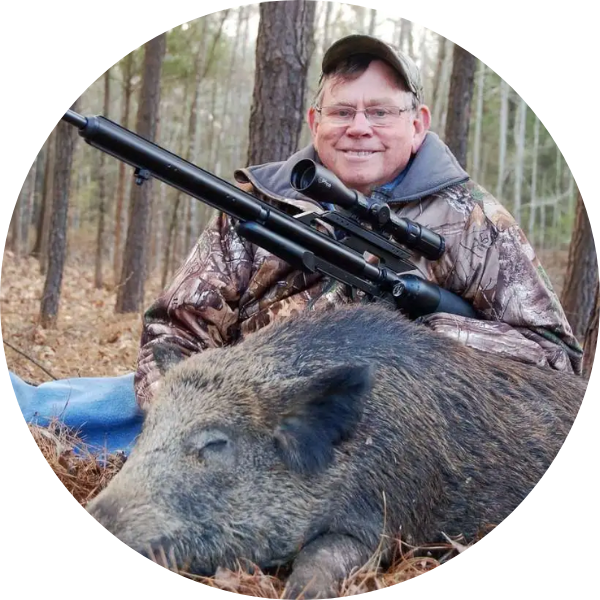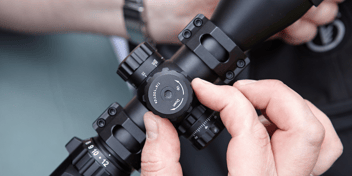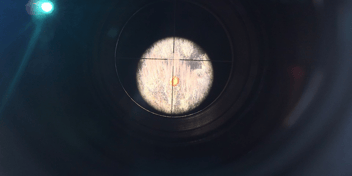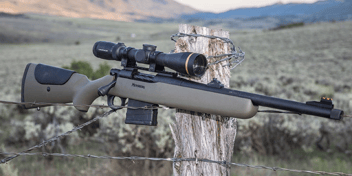
Wild hogs often become almost entirely nocturnal during the winter months when cover is sparse. They’ve been exposed to hunter pressure for several months, and being the highly intelligent animals they are, they prefer to feed under the cover of darkness when they have the woods to themselves.
Due to their nocturnal nature, hog hunting at night is not only beneficial from a success standpoint—but it’s an adrenaline-pumping experience.
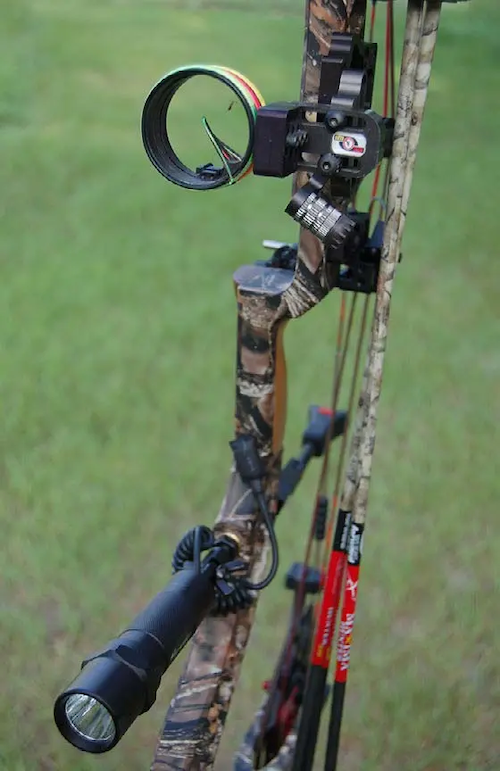 |
| Here is a close-range hog setup using a bow-mounted light. The trick here is to adjust the light beam before the hunt, so that it’s centered on the ground directly in front of the bow. |
The critter’s eyesight is touted as being pretty bad, but I’ve seen them spot movement and spook from at least a couple hundred yards away. What they might be missing in the eyesight department is more than compensated for in their olfactory system.
When hog hunting at night, it’s not the hog’s eyesight I have to contend with, but his nose.
I have intentionally scattered corn in heavy cover (including oak leaves six inches deep) and watched hogs sniff out and devour every kernel. In Germany, hogs are trained to sniff out truffles growing a couple of feet under the ground.
Obviously, one needs to see hogs at night in order to shoot them, and through the years, I have employed all sorts of ways to accomplish this. My tactics have included using DC light bulbs wired in series to car batteries to using flashlights with lenses covered in red cellophane tape.
The Story
I arrived at the spot where I have been baiting hogs about 6 p.m. on a cold, late-winter Texas afternoon. The sun was about to dip over the horizon as I made the walk back into the bottoms, where my ground blind and baited area awaited. I had that feeling that this was going to be an exciting night.
I have my trail camera mounted to an oak sapling a few feet from a spot back in the woods where I hand feed a couple of gallons of corn on an almost daily basis.
The spot is a short 15-minute ride from my house on my “hunting buggy” and I enjoy studying the porkers’ patterns throughout the year. For the past 14 years, I have annually harvested several hogs from this spot and the vast majority have been taken after sunset.
A Honey Hole
The images the camera captured indicated there was a smorgasbord of wild hogs coming to my hotspot. Most of the activity was between 8 and 10 p.m. And with a dark moon, the deer woods are as black as a cave.
My hog honey hole is situated between a slough and several old gravel pits that hold water year around. It is a natural travel corridor for all wildlife and a hotspot for hogs that live in the area. It also houses those “roving” sounders that are often on the move during the winter months in search of food when agricultural crops and native mast are depleted.
Soon after I settled into my blind, darkness descended on the remote stretch of bottomland. Stars begin to twinkle from the heavens and a sense of tranquility settled over the dark woods. There’s something very exciting about spending time in the woods anytime, but especially so when hunting on a cold, quiet winter’s night.
Thanks to the images on my trail camera, I felt almost positive that wild hogs would be disturbing my peaceful setting, assuming I stayed put for a couple of hours. Every little sound was magnified by the darkness. I heard a distant pack of coyotes open up with their evening serenade and a couple of owls shared greetings somewhere back in the deep woods.
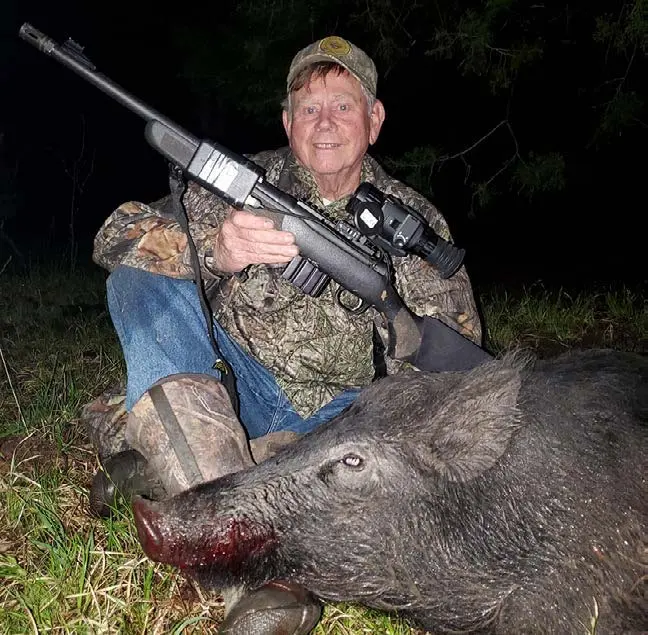 |
| Luke Clayton with a fine boar he took at night using his .223 caliber Mossberg Patrol Rifle using an AGM Global Vision Rattler thermal scope. |
I use a couple of thermal scopes by AGM Global Vision for all my night hunting these days. While there are much more expensive thermal scopes on the market, I’ve found the Rattler and the Adder to be ideal for my kind of hunting.
The first thermal scope I used was the Rattler and I liked it so much, when the Adder came out, I couldn’t resist and mounted one on another of my dedicated ‘hog’ rifles. The Rattler is a more compact scope, and the Adder resembles a conventional rifle scope.
Both have built-in video capabilities and the Adder also records sound. I use an external battery when hunting with the Rattler, but the internal battery on the Adder is sufficient for a full eight hours of night hunting, which is way more than I’ve ever needed.
Mounted on my Mossberg Patrol rifles in .223 caliber, I feel confident making shots out to about 150 yards.
For safety reasons, that’s as far as I wish to be shooting at night. I honestly can’t remember shooting a hog at night over 100 yards because I set up for ‘closer’ shots, usually around corn feeders or oak or pecan trees where hogs are feeding. Both scopes are quite capable of much longer shots, which could come in very handy hunting hogs in open country.
But most of my hog hunting at night is done in the deer woods. Some hog hunters might consider my rig a bit light for hog hunting. I concede that it is for long shots at running hogs, where precise bullet placement is difficult. But neck shots at close range always anchor my pork “in place.” I hunt mostly for fresh pork, and the Hornady 55 grain CX bullets pack plenty of punch to drop the hog while damaging very little meat.
However, thermal scopes are in my opinion the gold standard for hog hunting at night. They are also the costliest. AGM Global Vision offers an entry-level thermal scope for around a thousand dollars that is more than adequate for shooting hogs out to about 100 yards. This is only a few hundred dollars more than a digital night vision scope that uses IR to identify hogs.
I’m not knocking digital scopes; I’ve killed a bunch of hogs using them, but they do come with some inherent challenges. Light refracts off objects between the shooter and target, such as branches, brush, and other materials. This “lights up” the image when viewed through the scope and that obscures the target. Digital night vision works great where there is a clear line of sight, but I think it is next to worthless when used in heavy cover. I’ve found it very effective with clear shooting lanes from my position to a feeder used to attract hogs.
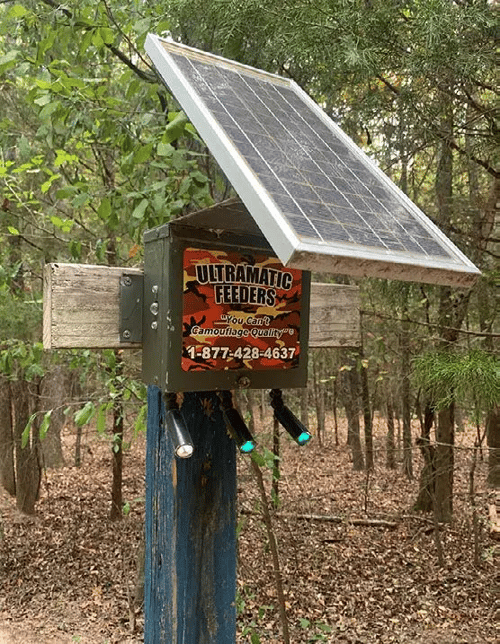 |
| The Feedlight by Ultramatic Feeders lights up the area around a corn feeder. The Feedlight gives just enough light for the hunter to see the hogs well enough to shoot, but not enough to spook the porkers. |
Worthy Spotters
Regardless of the type of scope used, an inherent problem with any thermal or digital scope is the fact that in order to see into the darkness, one must mount the rifle to look through the scope. This is where, when night hunting, a lightweight thermal spotter is worth its weight in gold.
I use the Taipan thermal spotter, which is lightweight. With its 19 mm viewfinder, I can easily scan several hundred yards around my hunting position if visibility permits.
Then, I can see approaching hogs well before they get within shooting position. The advantage of using a spotter is pretty obvious. Putting the lightweight spotter up to the eye is much easier than mounting and tracking game with a rifle.
Because thermal scopes and spotters register the heat signature of game, they are both very helpful in recovering downed animals.
I’ve used my spotter to locate several hogs that ran a few yards after being hit before expiring. The animal’s bodies retain heat for some time after they expire, and the thermals can make for a quick recovery even on the darkest of nights.
I’ve also used bow-mounted lights with red or green lenses for up-close work on hogs at night. The trick here is to make sure to adjust the beam from the lights (they typically screw into the bow’s stabilizer) to illuminate the area 20 to 30 yards in front of your shot.
I made the mistake years ago of simply screwing the light onto the bow and going hunting. I stalked downwind 14 yards from a big boar. Every time I tried to center his shoulder with a sight pin, the beam was a good 10 feet over his back, and I lost sight of my hog!
I’ve also had success with lights that come on automatically around feeders. Some of these lights are programmed to come on in very low beam and slowly intensify. The Feedlight by Ultramatic Feeders comes with a solar panel to keep the battery charged.
Hogs get adjusted to lighted areas, especially around feeders, and pay little attention to the light after a few nights. With these lights, it’s usually possible to crank a conventional scope down to its lowest power and clearly identify the hog and the scope’s crosshairs at a relatively close range. On a night with a full moon, I have shot hogs up to 75 yards out using this method.
If you are a serious hog hunter and you hunt around areas where hogs are pressured, you will probably at times have to go hog hunting at night. Actually, I have come to prefer it. There is something very tranquil about sitting in the night woods waiting for a wild porker to break the silence and get your adrenaline pumping.
Originally featured in North American Outdoorsman.
About the Author
